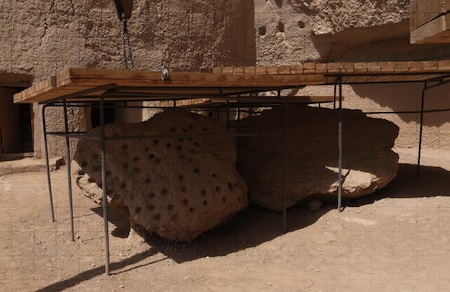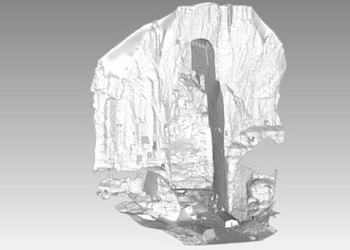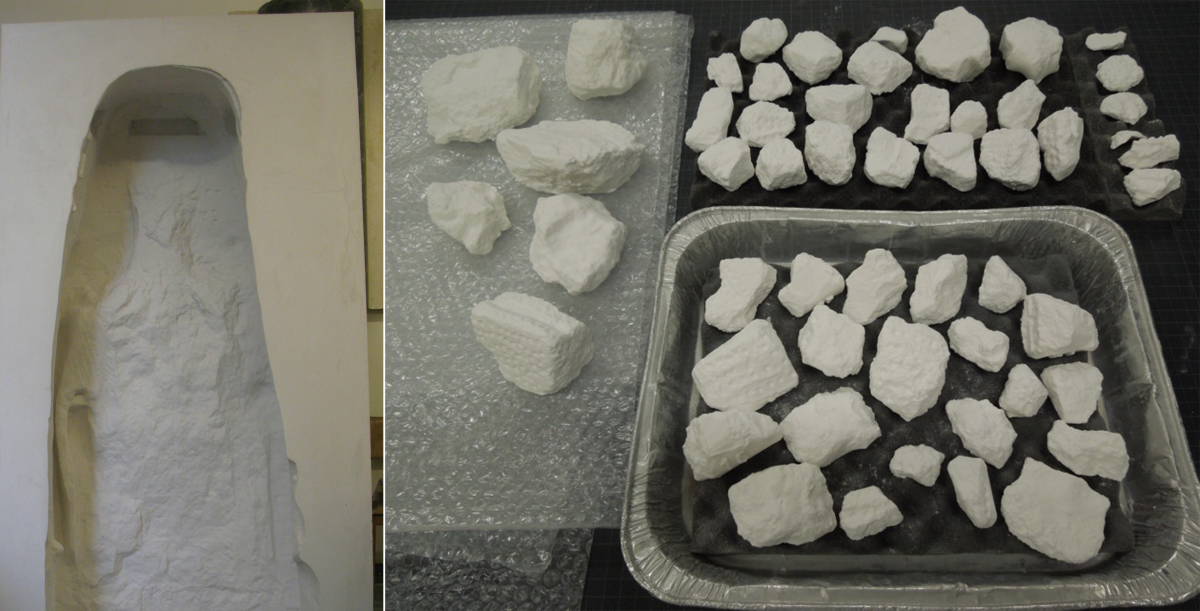
In the sandstone cliffs circling the Valley of Bamiyan in central Afghanistan, two enormous, conspicuous niches stare out from the rock. They were once the homes of the Buddhas of Bamiyan: two colossal buddhas that monks carved out of the stone and coated with stucco. The larger of the two measured 53 meters tall, and the smaller one came in at 35 meters tall. Examples of Gandhara art, the statues, built in 554 AD and 507 AD, respectively, were reminders of one of the world’s great civilizations and were once the largest standing buddha carvings on the planet. But on March 12, 2001, explosive devices destroyed the 1500-year-old statues, robbing an already war-stricken country of vital symbols and cultural identifiers that underscore the area’s unique blend of Greek and Buddhist cultures. (Above: The Valley of Bamiyan with two empty niches in sandstone cliffs)
 Currently, an international team of restorers, architects and engineers are rebuilding the Buddhas of Bamiyan and hoping to restore some symbolic value for the Afghan citizens, and 3D Systems is helping. The restoration team is using a combination of Geomagic Studio® scanning software and a ProJet® 3D printer with ColorJet technology to prepare for the monumental task ahead. In 2009 they began planning for the reconstruction of the Buddhas of Bamiyan, the chambers of which were declared a World Heritage Site in 2003. The project is funded by a group of countries and organizations, led by UNESCO (United Nations Educations, Scientific and Cultural Organization) and ICOMOS (International Council on Monuments and Sites). (Left: Fragments of the Buddhas)
Currently, an international team of restorers, architects and engineers are rebuilding the Buddhas of Bamiyan and hoping to restore some symbolic value for the Afghan citizens, and 3D Systems is helping. The restoration team is using a combination of Geomagic Studio® scanning software and a ProJet® 3D printer with ColorJet technology to prepare for the monumental task ahead. In 2009 they began planning for the reconstruction of the Buddhas of Bamiyan, the chambers of which were declared a World Heritage Site in 2003. The project is funded by a group of countries and organizations, led by UNESCO (United Nations Educations, Scientific and Cultural Organization) and ICOMOS (International Council on Monuments and Sites). (Left: Fragments of the Buddhas)
For Ing. Sekandar Ozod-Seradj, one of the engineers on the restoration mission, this is a passion project. An Afghani by birth and a member of ICOMOS Germany, he is deeply rooted in Afghan culture and the monuments it thrives on. Ozod-Seradj is so dedicated that he founded the Afghan Rehabilitation Group e.V., whose projects include the headquarters of the Afghan president, Del Kusha, and a royal palace named Kuti-e Baghtscha. But as an ICOMOS-member,the Buddhas of Bamiyan restoration is his biggest yet, and he’s implementing Geomagic Studio and a ProJet 3D printer to help.
Geomagic Studio is used for archaeological and archive projects all over the world because it reliably transforms 3D scan data into highly accurate surface models, and it includes an easy-to-learn user interface that works great in the field. So after collecting and securing all the large remains of the Buddhas, cataloguing and crating many of these delicate pieces of plaster and wood, architects at Ozod-Seradj’s Architects Seradj + architecture firm scanned many of the larger debris pieces in addition to the niches themselves. The pieces were measured by their magnetic alignment and sediment structure, and the goal was to get a better idea of how and where each piece fit. After the scanning was complete, the team processed these huge amounts of data, performed manual hole repair and created watertight surface models in Geomagic Studio. Once the debris pieces were meshed and repaired using Geomagic Studio’s Mesh Doctor tools, they were 3D printed at 1/25 size using a 3D Systems’ ProJet 3D printer with ColorJet technology. In addition, they 3D printed the niches. All together, they’ll use these accurate scale models to practice reassembling the Buddhas piece by piece and to plan the logistics of the reconstruction. Considering the region’s challenging terrain and the large equipment required for the final reconstruction, the team must know what challenges lay ahead, and the scale model assembly will enable them to prepare for some of those challenges. (Below left: Scan of the large niche in Geomagic Studio. Below right: 3D printed niche and debris pieces)


The international team of specialists from Afghanistan, France, Italy, Japan and Germany has already seen a growing positive attitude from the region’s citizens. And that attitude, they hope, will spread going forward. “Through our work we give Bamiyan and its residents the chance to be in this unique historic and scenic area,” says Sekandar Ozod-Seradj. “And through doing this we strive to give them a future of tourism and finally find peace.”
Click here to learn more about Architects Seradj +.
Click here to learn more about the Afghan Rehabilitation Group.



